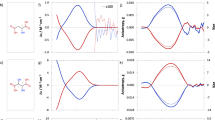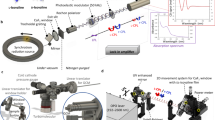Abstract
SINCE Pasteur showed that the amino acid asparagine in plants was purely one optical isomer, constant interest has centred around the question of optical activity in life. The quantities of D-amino acids in the biosphere are practically negligible and none has ever been found in any enzyme or other protein, whereas the abundance of L-amino acids is well known. Many of the molecules important to living processes can be synthesised1 in conditions which may have prevailed on a primitive planet and it is easier to suggest a prebiotic synthesis of a racemate than to explain an enantiomeric selection. Whereas many workers claim the clue might be found in various stereo-selective mechanisms, likely to have operated already at the stage of the ‘chemical evolution2–5’, no example of the selection of a biologically crucial compound by means of circularly polarised light has been previously reported. Apart from an effect due to an enantiomorphous relationship between matter and antimatter6–8, this is the only mechanism with selection capacity in a large system (the Earth)9. We report here that tartaric acid, α-alanine and glutamic acid partially resolve under circularly polarised irradiation. The L-amino acid dominance in the biosphere can by analogy, be explained by a selection caused by circularly polarised interstellar ultraviolet radiation.
This is a preview of subscription content, access via your institution
Access options
Subscribe to this journal
Receive 51 print issues and online access
$199.00 per year
only $3.90 per issue
Buy this article
- Purchase on Springer Link
- Instant access to full article PDF
Prices may be subject to local taxes which are calculated during checkout
Similar content being viewed by others
References
Miller, S. L. Science 117, 528–529 (1953).
Bonner, W. A. & Flores, J. J. Origins of Life 6, 187–194 (1975).
Bonner, W. A. J. molec. Evol. 4, 23–39 (1974).
Decker, P. J. molec. Evol. 2, 137–143 (1973).
Bonner, W. A., Kavasmaneck, P. R. & Martin, F. S. Origins of Life 6, 367–376 (1975).
Lee, T. D. & Yang, C. N. Phys. Rev. 104, 254–258 (1956).
Ulbricht, T. Origins of Life 6, 303 (1975).
Bonner, W. A., Van Dort, N. A. & Yearian, M. R. Nature 258, 419–421 (1975).
Nordén, B. (in the press).
Nordén B. Chem. Scr. 8, 46–48 (1975).
Kagan, H. B., Balavoine, G. & Moradpur, A. J. molec. Evol. 4, 41–48 (1974).
Fox, S. W. & Dose, K. Molecular Evolution and the Origin of Life, 54–55 (Freeman, San Francisco, 1972).
Author information
Authors and Affiliations
Rights and permissions
About this article
Cite this article
NORDEN, B. Was photoresolution of amino acids the origin of optical activity in life?. Nature 266, 567–568 (1977). https://doi.org/10.1038/266567a0
Received:
Accepted:
Issue Date:
DOI: https://doi.org/10.1038/266567a0
This article is cited by
-
QSPR modeling of optical rotation of amino acids using specific quantum chemical descriptors
Journal of Molecular Modeling (2018)
-
The origin and amplification of biomolecular chirality
Origins of life and evolution of the biosphere (1991)
-
A mechanism for molecular asymmetry
Journal of Molecular Evolution (1991)
Comments
By submitting a comment you agree to abide by our Terms and Community Guidelines. If you find something abusive or that does not comply with our terms or guidelines please flag it as inappropriate.



